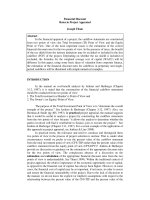Globalization and Cross-Cultural Issues in Project Management pdf
Bạn đang xem bản rút gọn của tài liệu. Xem và tải ngay bản đầy đủ của tài liệu tại đây (48.08 KB, 5 trang )
© 2004, 2005 Dennis G. Ballow, Sr., PMKT, Inc., All Rights Reserved
Globalization and Cross-Cultural Issues in Project Management
Dennis G. Ballow, Sr., MAED, PMP’ Project Management Knowledge Transfer, Inc.
Abstract
With hot topics like globalization and cross-cultural opportunities in the Asia Pacific rim, one might think it would be
easy to research the implications of cross cultural issues. Rather, what the writer found was a significant discussion all
around the periphery but little in-depth analysis. Discussion prevailed on the socio-economic and technological
ramifications. Others resources focused on the language issues but little work was intuitively available on the subtleties of
cross cultural issues one may encounter.
Based on experience working in the Asia Pacific rim for two years as a PMO Manager, and training PM’s in many
European countries, I decided that understanding international socio-cultural issues encountered in business is essentially
at the heart of the issues companies will encounter in globalizing operations. Therefore, the writer will approach the cross-
cultural issues from a personalized understanding based on his many months of first hand mistakes in understanding
cultural issues encountered in Asia Pacific. I will base my observations of cross-cultural issues on my experiences in
working most closely with individuals from China, Hong Kong, Malaysia, Taiwan, Singapore, Japan, and India. Naturally
there are more countries in the Pacific Rim but these mentioned provided the most opportunity for interaction.
I want to also acknowledge the contributions of my wife, Helena Shiu Leung Chow Ballow, whom I initially met in Asia.
Her wisdom, coaching, and meaningful insights on the many differences between Western and Eastern business and
cultural practices were, and remain till this day, illuminating, helpful and daunting.
Introduction
Clearly we all understand to some degree the impact of cultural issues in communications. If nothing else, we have
encountered situations where language was the barrier. But language may be the smallest of the issues when dealing with
other cultures. Even when we pull out our Translation Guides or employ translators we may get pass some of the language
difficulties. But from the writer’s experience, language is the least of the issues. Ingrained and systemic patterns of
cultural behaviours can be so subtle as to completely deny meaningful communications.
I found a really good example of just how easily cultural variances can cause communications problems. In this case the
issues was “psychological filtering” of appearance or gesture. I would think is would also be easy for the reader to
extrapolate this example into some experiences that may have encountered even in the West. Timofeev (2002), in an
article in National Concepts and Globalization, provided the following example:
“The idea or rather the hypothesis that underlies this paper was stimulated by a trivial chat with a friend of mine. Being a
linguist by trade, Russian by origin and living in Finland, she is well aware of cross-cultural discrepancies and provided me
with a curious example. It was a TV commercial of an international brand of Persil washing powder. Two young ladies were
shown sitting in a crowded place, some restaurant or a café. One of the ladies notices quite a peculiar manner her friend has
chosen to wear her wristwatch. It was placed above the cuff of her blouse. It turned out in a second that the only reason for
placing her watch there was to cover some stain that regular detergents failed to deal with. "Oh dear, you should use Persil
instead!"
So everything was straight and simple. But before that, when the attentive and thoughtful lady was describing her version of
her friend's peculiar manner of wearing her watch in Finnish (and I guess that the German, French and English versions were
quite similar to that in Finnish), she said: "You are such a busy person. You have to wear your watch so that it can always be
seen." While in Russian the same lady made quite a different guess: "Your watch must be terribly expensive since you wear it
so that everyone can notice it." The Russian version, when translated into English, seems to be full of irony; it describes the
lady's manner as showing off. It would definitely undermine the main purpose of the ad, which was to provide a friend and
those watching the commercial with thoughtful advice about using detergents. (p. 1)”
To understand the issues we must start with a framework definition of culture. There are just too many definitions of
culture, and even speaking the same language, we might get off tract pretty quickly. So, the writer did some research and
decided on the following foundational definition of culture upon which to proceed. This is summarized by Kim (1999):
“As the author himself confesses that there are 160 different definitions of the term 'culture' and picks up the definition of
scholar Clyde Kluckhohn. According to him, "Culture consists of patterned ways of thinking, feeling and reacting, acquired and
transmitted by symbols, constituting the distinctive achievement of human groups, including their embodiment in artifacts; the
essential core of culture consists of traditional (i.e. historically derived and selected) ideas and attached values."
continued
Globalization and Cross-Cultural Issues in Project Management, page 2
© 2004, 2005 Dennis G. Ballow, Sr., PMKT, Inc., All Rights Reserved
Another scholar, Triandis, presents a psychological perspective to the description. "Culture is a subjective perception of the
human - made part of the environment. And this includes the categorization of social stimuli, associations, beliefs, attitudes,
roles, and values individuals share." Culture thus is a melting pot consisting of many things gathered over a period of time in
which religion and language play a great role. (p.228)”
Now, with a definition of culture in hand, and a real life example to back up the idea, we will look at some relatively
common cultural issues that impact communication, and thus, also have implications for Western corporations working in
the Asia Pacific Rim.
Cross-Cultural Issues and Implications
I will present the materials in a table format such that it may be easier to digest. A simple summary provided by Bhagat et
al (2002 provides a good stepping-stone for analysis of the cross-cultural issues:
Cross-border transfer of organizational knowledge is most effective in terms of both velocity and viscosity when the type of
knowledge (i.e., human, social, or structured) being transferred is simple, explicit, and independent and when such transfers
involve similar cultural contexts. In contrast, transfer is least effective when the type of knowledge being transferred is
complex, tacit, and systemic and involves dissimilar cultural contexts. (p. 204)
Table 1: Cross-cultural Implications – Asian (China, Hong Kong, Malaysia, Taiwan, Singapore, Japan) and the West
Implications
Cross-culture
Dimension
Asian Perspective American Perspective Implications
Language Not that complicated to the Asian.
Foreigners should have more respect
and learn the language.
English is the international
business language so everyone
should use it.
It is generally good practice to
“localize” materials when feasible.
Local words and expressions
sometime just do not properly
translate for English and may
actually be offensive.
Individualism
vs. Collectivism
Strong Collectivism - The Asians
depend more on groups or institutions
to determine what they should do and
emphasize loyalty to the group. They
are more likely to cooperate with
others to avoid risks and reduce
responsibilities. Their value systems
appreciate duty to the group and
harmony among its members while
pursuing personal goals is viewed
rather negatively in Asia.
Strong Individualism - They rely
on their own view to determine
what they should do. They tend to
work alone and are reluctant to
cooperate because their
individualism and masculine
culture view cooperation in
general as a sign of weakness
and place a high value on
independence and control.
A focus on team activities and
collaboration vs. individual
competitive activities is preferred.
Cooperation The Asian person does not consider
contracts as seriously as the
Americans. They think there will
always be changes and the contracts
can be reasonably modified according
to changes. Instead, they tend to pay
more attention to relationships than
contracts.
Americans place greater
importance on contractual
safeguards than the Asian. They
believe that contracts can ensure
that their partners' tendencies to
focus on individual goals and
aspirations do not interfere with
their own individual goals and
aspirations.
Nothing is cast in stone for the
Asians. Authority is seldom, if
ever, challenged. But when
encouraged and trust is gained
by the instructor, students will
interact better, and challenge
each other in a negotiative
manner as not to create a
”save face” problem. This
takes much longer that you will
ever plan – so take time to let
the process work itself
through.
Asian employees seldom have
the chance to really participate
in the decision-making
process. So activities requiring
decisions may well take
longer.
continued
Globalization and Cross-Cultural Issues in Project Management, page 3
© 2004, 2005 Dennis G. Ballow, Sr., PMKT, Inc., All Rights Reserved
Implications
Cross-culture
Dimension
Asian Perspective American Perspective Implications
Uncertainty
Avoidance
Risk-avoiding - Asians have higher
values for uncertainty avoidance
than USA, which shows that Asians
are relatively risk-avoiding
Risk-taking - Americans are
relatively risk-taking. USA has a
short-term orientation while Asians
have a long-term orientation
The tendency is to research,
research, and research until
there is more certainty on an
issue or assignment. Again
this takes more time than ever
planned. No one wants to et
the other team member down
so certainty is best to “save
face” within the collective.
Masculinity/Fem
ininity
Medium Femininity – To deal with a
difficult or controversial request,
indirect forms of influence are
preferred by Asian managers to
avoid losing face and damaging
relationships.
Medium Masculinity –
Western partners may get totally
confused by the roundabout way the
Asians use to solve seemingly
simple problems. The different ways
that Chinese and American
managers resolve conflicts seem to
find support from Weaver's finding
that feminine societies prefer to
resolve conflict through negotiation
and compromise (Weaver, 2000).
As noted in the other
categories above, while team
activities are critical to success
of a course, the time allotted
for all activities must be given
a high priority.
Conflict
Resolution
Personal relationships are
emphasized. They will try to use
indirect ways to avoid direct and
open conflict. When they face
conflict, they prefer to use authority
to suppress it, or settle things in
private. They prefer to resolve
conflict through negotiation and
compromise. (Weaver, 2000).
American managers are used to
confronting problems directly and
bringing things out in the open. To
resolve differences, American
managers will prefer to use tactics
that involve directly confronting
others with rational arguments,
factual evidence, and suggested
solutions (Ting-Toomey, 1985).
Western business people will
realize that while they “have the
authority” to manage conflict it is
not a license to kill.
Extreme caution and skill is
required to bring a group through
conflict without causing save face
issues.
Time, time, time.
Work Group
Characteristics
Asians are relational-oriented
countries in which people place
great importance on personal
relationship. Living in a collectivism
society, the Asians view people
differently as "in-group" and "out-
group". They have much higher
confidence in "in-group" members
than "out-group" members. But the
passing of time, and the
development of relationship, the out-
group members may turn into in-
group members
American managers may encourage
their group members to learn from
each other, to focus on task rather
than on social and interpersonal
relations, and to build the confidence
required for superior performance
(Sosik and Jung, 2002). They place
a much higher importance on the
task or business deal and hope to
focus very quickly on specific
business matters. They are
achievement oriented, that is "work
first". They don't think establishing
personal relationship is necessarily
involved in the work.
Once teams are formed, changing
members will create problems for
the new member. Avoid this
whenever possible.
Motivation
Systems
Collectivistic cultures emphasize
cooperation, interdependence, and
group goals, and thus prefer plans
that support group harmony
(Aguinis, 2002). Most Asians believe
that the sense of belonging to the
group and devotion to the group are
important. They hold the view that
one's success is mainly based on
group work, so one cannot claim the
reward just for oneself. In that case,
the equality principle is reflected in
the motivation system.
In American value systems, great
emphasis is placed on individual
achievement, and they are expected
to achieve success only by their
individual efforts. They value
competition, achievement and
personal goals, and therefore, desire
to have plans that recognize
individual contributions.
Motivate and encourage
individuals one-on-one.
Motivate and encourage all
groups publicly unless the news is
bad.
continued
Globalization and Cross-Cultural Issues in Project Management, page 4
© 2004, 2005 Dennis G. Ballow, Sr., PMKT, Inc., All Rights Reserved
Because most of the areas discussed in Table 1 also apply to Indian culture, we will only look at a few areas that are subtle
variances in implications. This time I will ask the reader to think about the implications based on a review of Table 1.
Let’s see if you have started to figure it out.
Table 2: Cross-cultural Implications – India and the West
Western Non-Western
1. Christianity concerned with absolute moral values,
differences between good and evil, and redemption of the
soul.
1. Non-Western religions focus on virtue. Buddhism and
Confucianism providing an ethical code of behavior.
2. Society is built on legalistic contractual relationships. 2. Society is built on direct personal relationships.
3. Individualistic orientation. 3. Group orientation. Clan, Caste, Tribe.
4.Behavior controlled by rules, punishments and rewards 4. Behavior controlled by group adaptation. Departures
from the group norm are accompanied by feelings of
shame.
5. Attribution groups are important (family, class,
occupation).
5. Frame groups are important (village, neighborhood,
company, region, and nation).
6.Weak hierarchical structure 6. Strong hierarchical structure.
7. Important values are freedom and personal conscience. 7. Important values are security and obedience.
8.Need for self-assertion 8. Need for coordination
Western Non-Western
9.Contractual relationships based on rights and duties 9. Personal relationship based on mutual obligations and
mutual dependence.
Source:
Summary
I can relate to you from personal experience that the content in these tables, and the preceding “watch” example, are
but a few of the real cross-cultural issues one will encounter. In implementing project management around the world,
I encountered topic-critical words that could absolutely not be translated in some languages. On some occasions, I
encountered individuals who had little tolerance for Western ideas. For example, in presenting certain PM concepts
in China about Change Management I discovered they were considered impolite and inappropriate. Why? After the
contract is awarded is when the two parties actually sit down and really come to agreement on what will be
delivered. The original SOW can only be considered a general reference point and asking for additional funding for
changes in just not generally accepted business conduct. You can see that in some areas we absolutely thousands of
miles apart in many ways.
More than finding great new insights about cross-cultural issues, I find it more about personal reflection on how I
could have done things better. Hind site is always viewed from a 20/20 perspective. Much of what I have learned
about cross-cultural issues was trial and error, and error, and error. The writer hopes that sharing some of my
experiences will help you avoid some of the same problems and make you more sensitive to the inherent cultural
issues you will encounter.
Globalization and Cross-Cultural Issues in Project Management, page 5
© 2004, 2005 Dennis G. Ballow, Sr., PMKT, Inc., All Rights Reserved
Resources
If any reader would like to pursue a more detailed understanding, may I suggest the following resources?
• Fred Schneiter, Getting Along with the Chinese for Fun and Profit (Regal Printing, Hong Kong, 2000.
• Yuan Wang et al, An Insider’s Guide to Business Culture in China, Butterworth-Heinemann Asia, 1998.
• Jiang Wei, China Business Strategies, Asiapac Books Pte. Ltd., 1995.
•
References
Aguinis Herman, 2002. "The Search for Universals in Cross-Cultural Organisational Behaviour". Organisational
Behaviour: The state of the science (2nd Ed) Mahwah, NJ: Lawrence Erlbaum Associates.
Pan Fan, K., Zhang, Zigang (2004), Cross-cultural challenges when doing business in China, Singapore
Management Review, 01295977, 2004 1st Half, Vol. 26, Issue 1. Extracted February 28, 2004 from
Business Source Premier at />
Sosik, John and Jung Dong, 2002. "Work-group characteristics and performance in collectivistic and individualistic
cultures". The Journal of Social Psychology. Washington, pp 5-23.
Weaver, K Mark, 2000. "Attitudes toward Cooperative Strategies: A Cross-Cultural Analysis of Entrepreneurs",
Journal of International Business Studies, 31, Fourth Quarter 2000: pp 591-609.
Timofeev, Valery (2002), National Concepts and Globalization, TRANS; Dec2002, p159, 4p, 4 diagrams. Extracted
February 28, 2004 from Business Source Premier at />
Ting-Toomey S, 1985. Toward a theory of conflict and culture. In WB Gudykunst, LP Stewart, S Ting-Toomey
(eds). Communication, Culture and Organizational Processes, pp 71-86. Beverly Hills, CA: Sage.
Bhagat, Rabi S., Kedia, Ben L., Harveston, Paula D., Triandis, Harry C. (Apr2002), Cultural Variations in the cross-
border Transfer of Organizational Knowledge, Academy of Management Review; Apr2002, Vol. 27 Issue
2. Extracted February 28, 2004 from Business Source Premier at
/>
Dennis G. Ballow, Sr., MAED, PMP
Project Management Knowledge Transfer, Inc.
2725 Woodson Drive,
McKinney, Texas 75070
(O) 972-540-0718
(M) 214-385-5097









